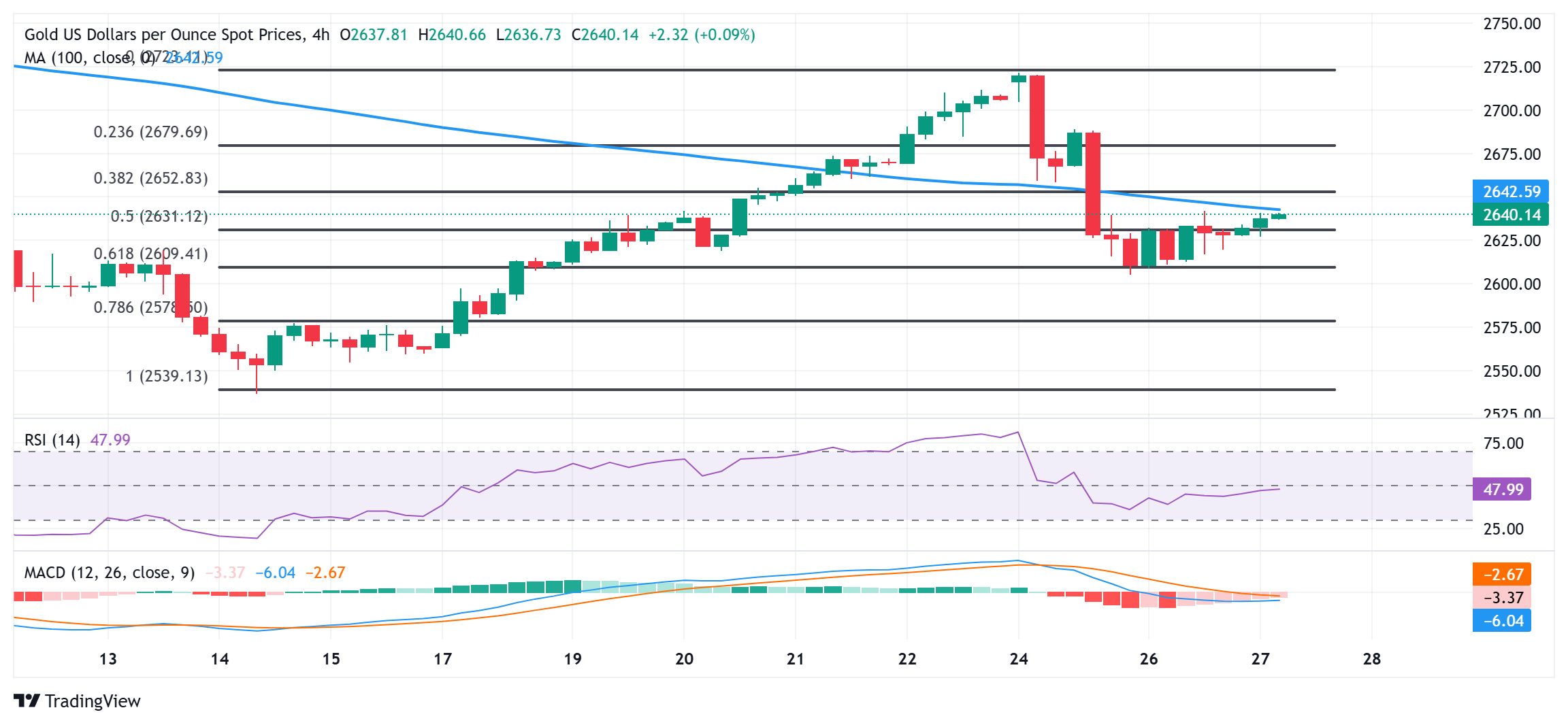- Gold price gains traction for second day in a row amid trade war concerns.
- USD price action and geopolitical risks also benefit XAU/USD as a safe haven.
- Traders await the release of US Q3 GDP and the US PCE Price Index for further impetus.
Gold price (XAU/USD) attracts some follow-through buying during the Asian session on Wednesday and looks to consolidate the overnight bounce from the $2,600 area, or a one-week low. Lingering geopolitical risks stemming from the protracted war between Russia and Ukraine, along with concerns over US President-elect Donald Trump’s tariff plans, are driving some safe-haven flows into the precious metal for the second day in a row.
Meanwhile, the US Dollar (USD) is consolidating near the lower end of its weekly range despite positive US macroeconomic data on Tuesday and turns out to be another factor supporting the price of gold. That said, the prospects of a less dovish Federal Reserve (Fed) could limit the yellow metal from performing. Traders are also awaiting US inflation data for clues on future rate cuts before opening new directional positions around XAU/USD.
Gold price continues to attract safe haven flows after Trump’s tariff threats
- US President-elect Donald Trump has pledged to impose tariffs on all goods entering the US from Canada, Mexico and China, driving some safe haven flows into the price of gold.
- Ukraine reported the largest Russian drone attack on its territory on Tuesday. Russia used a hypersonic missile in Ukraine last week and is advancing at the fastest rate since the 2022 invasion.
- Russia is reportedly using North Korean troops in Ukraine. Ukraine is attacking targets inside Russia with Western-supplied missiles, raising the risk of further escalation of the conflict.
- The long-running conflict in the Middle East de-escalated after US President Joe Biden announced that Lebanon and Israel agreed to a ceasefire effective from 02:00 GMT this Wednesday.
- The Conference Board reported Tuesday that the U.S. Consumer Confidence Index rose to 111.7 in November, the highest level since July 2023, from 109.6 in the previous month.
- Minutes from the Nov. 6-7 FOMC meeting showed officials were divided over how much further they might need to cut rates and were uncertain about the direction of the economy.
- The CME Group’s FedWatch tool indicates that investors are still pricing in at 63% the possibility that the US central bank will reduce borrowing costs by 25 basis points at the December meeting.
- President-elect Donald Trump’s nominee for US Treasury secretary, Scott Bessent, is expected to take a more gradual approach to tariffs in a bid to rein in the budget deficit.
- The 10-year US government bond yield holds steady above a two-week low hit on Monday and the US dollar is seen consolidating near the weekly low.
- Wednesday’s US economic agenda includes the preliminary release of third quarter GDP and the Personal Consumption Expenditure (PCE) Price Index later in the North American session.
Gold price will likely face resistance near the 100-period SMA on the 4-hour chart
From a technical perspective, Tuesday’s nice bounce from the 61.8% Fibonacci retracement level of the recent rally and subsequent strength favor bullish traders. That said, the oscillators on the daily chart are yet to confirm a positive bias and suggest that the move higher will likely face stiff resistance near the 100-period SMA on the 4-hour chart. The said barrier sits near the $2,645 region, above which gold price could rise further towards the $2,665 zone en route towards the $2,677-2,678 hurdle before aiming to reclaim the round figure of $2,700.
On the other hand, the $2,624-2,622 region could offer some support before the $2,600 level. A convincing break below the latter will be considered a new trigger for bearish traders and will expose the 100-day SMA, around the $2,569-2,568 zone. This is followed by the monthly low, around the $2,537-2,536 area. Failure to defend such support levels will be seen as a new trigger for bearish traders and will set the stage for the resumption of the corrective decline from the $2,800 area, or the all-time peak reached in October.
Gold FAQs
Gold has played a fundamental role in human history, as it has been widely used as a store of value and medium of exchange. Today, aside from its brilliance and use for jewelry, the precious metal is considered a safe-haven asset, meaning it is considered a good investment in turbulent times. Gold is also considered a hedge against inflation and currency depreciation, since it does not depend on any specific issuer or government.
Central banks are the largest holders of Gold. In their aim to support their currencies in turbulent times, central banks tend to diversify their reserves and purchase Gold to improve the perception of strength of the economy and currency. High Gold reserves can be a source of confidence for the solvency of a country. Central banks added 1,136 tons of gold worth about $70 billion to their reserves in 2022, according to data from the World Gold Council. This is the largest annual purchase since records exist. Central banks in emerging economies such as China, India and Türkiye are rapidly increasing their gold reserves.
Gold has an inverse correlation with the US Dollar and US Treasuries, which are the main reserve and safe haven assets. When the Dollar depreciates, the price of Gold tends to rise, allowing investors and central banks to diversify their assets in turbulent times. Gold is also inversely correlated with risk assets. A rally in the stock market tends to weaken the price of Gold, while sell-offs in riskier markets tend to favor the precious metal.
The price of Gold can move due to a wide range of factors. Geopolitical instability or fear of a deep recession can cause the price of Gold to rise rapidly due to its status as a safe haven asset. As a non-yielding asset, the price of Gold tends to rise when interest rates fall, while rising money prices tend to weigh down the yellow metal. Still, most of the moves depend on how the US Dollar (USD) performs, as the asset is traded in dollars (XAU/USD). A strong Dollar tends to keep the price of Gold in check, while a weaker Dollar is likely to push up Gold prices.
Source: Fx Street
I am Joshua Winder, a senior-level journalist and editor at World Stock Market. I specialize in covering news related to the stock market and economic trends. With more than 8 years of experience in this field, I have become an expert in financial reporting.








